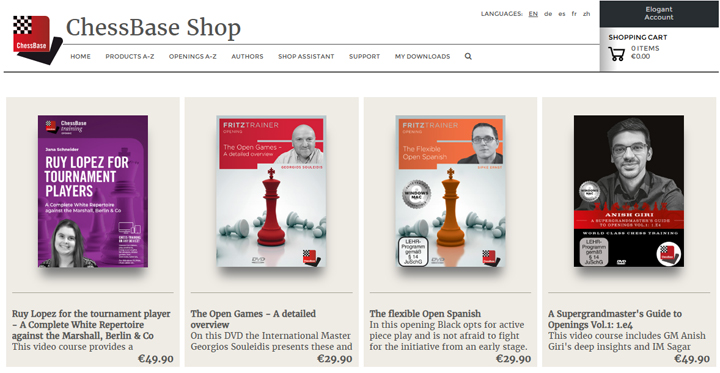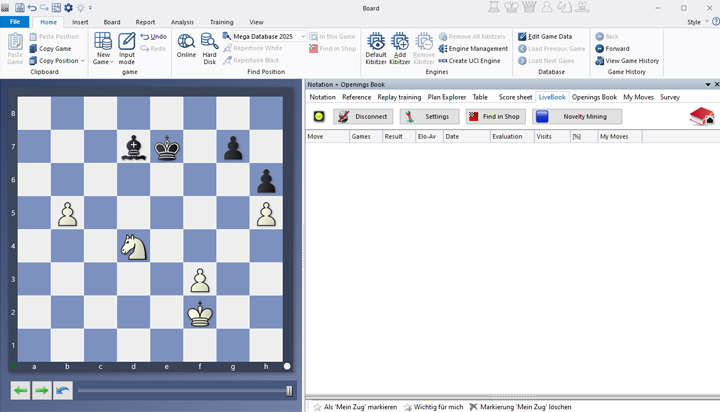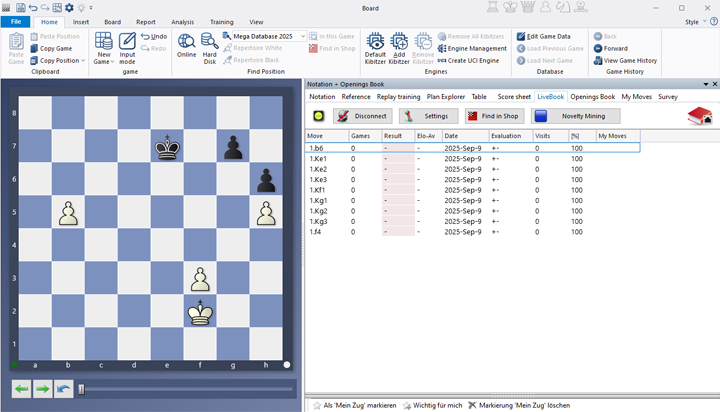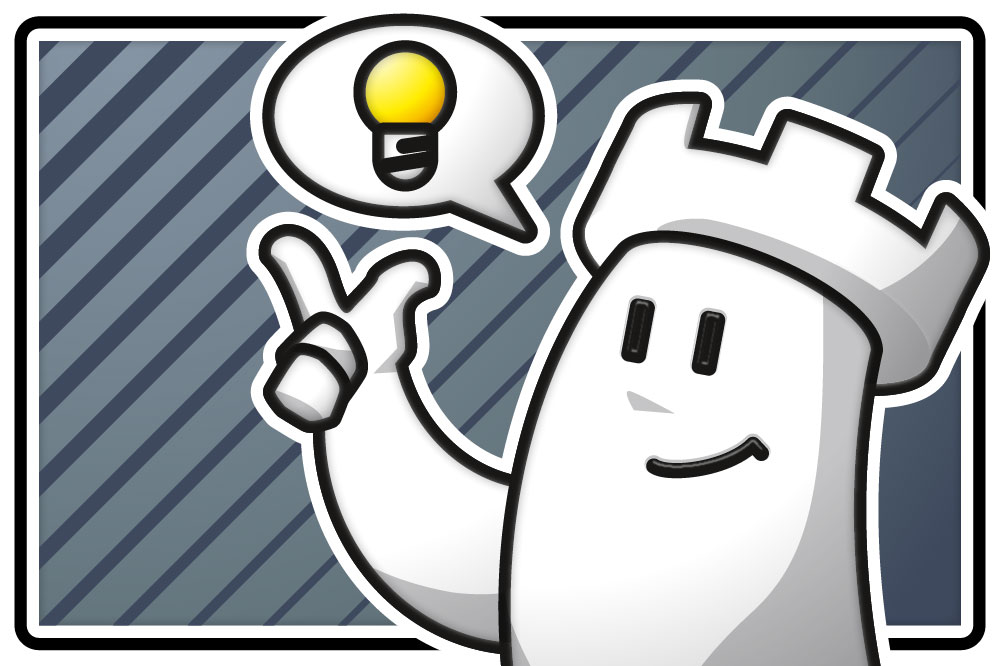LiveBook in Practical Use
Most ChessBase 18 users will probably use the LiveBook in connection with opening training, together with the Opening Book and/or the Reference function. That’s also how it is described in the online manual. Here’s a brief example:
This Spanish variation appeared recently in a game between Vincent Keymer and Frederik Svane at the Grand Swiss Tournament in Samarkand. On the right-hand side, the statistics for the game are displayed, and with the practical “Find in Shop” button, products on the Spanish Opening can be easily located in the shop (anyone wanting more detailed results can quickly find them under “Openings A–Z”):

Winning starts with what you know
The new version 18 offers completely new possibilities for chess training and analysis: playing style analysis, search for strategic themes, access to 6 billion Lichess games, player preparation by matching Lichess games, download Chess.com games with built-in API, built-in cloud engine and much more.
Endgame Analysis with LiveBook
In this installment, however, the focus is on a less well-known but still very useful application of the LiveBook: endgame analysis with LiveBook.
In the game mentioned above between the two German top players, the following endgame arose, which we have simply brought up on the board here using “Set up position (S)”:

At this point, we first notice that we see nothing! The results area on the right is empty. This is because, when you are logged in with your account, LiveBook accesses the Seven-Piece Endgame Database (if you are not connected, click on “Connect” — to the right of the board, above the results window). However, there are still nine pieces on the board.
Perfect endgame analysis and a huge increase in engine performance: Get it with the new Endgame Turbo 5! This brings the full 6-piece Syzygy endgame tablebases on a pendrive. Just plug it in a USB socket and you are set!
As so often in the endgame, the question may arise of how the position should be evaluated once the minor pieces are exchanged. Is the pawn advantage then enough to win? In this example the answer may seem straightforward, but the same approach can be applied to any more complicated endgame. We will demonstrate this with several further positions:

Even while “rebuilding” the position, you will see games appear in the results window on the right (provided the checkmark for “Search automatically” is activated) in which this basic structure occurred (see also: Set up positions and analyze).

Without the pieces, White’s position is simply winning thanks to the passed pawn and the extra pawn. This is also clear in the results display, which is now active for this seven-piece position. But what does it look like without the b-pawn?

Rules of thumb are the key to everything when you are having to set the correct course in a complex endgame. In this final DVD of his series on the endgame, our endgame specialist introduces you to the most important of these rules of thumb.
Suddenly White is worse and has to play accurately in order not to lose. As you can see in the “Evaluation” column, there are five drawing moves and three losing moves. As usual, you can click through the line of play by selecting the row with the move you want. You can also click once or several times on “Evaluation.” The column will then be sorted into winning, drawing, and losing lines:

Very practical, finally, is the option to search for a position in the MegaDatabase 2025: to do this, move the mouse pointer over the board, right-click, and select “Find position in MegaDatabase 2025…” (shortcut: SHIFT+F7):

Somewhat surprisingly, this position is not found in the MegaDatabase 2025. It looks different, however, if you remove the f-pawn and move the king two squares forward:

Here at the top right you see the variation statistics, and below them the corresponding games including a mini-board for preview. How to adjust the windows to your preferred size has already been explained earlier in this series: Standard layout or custom layout?
Conclusion
The LiveBook in ChessBase 18 is too often misunderstood as merely an opening tool. With just a few simple steps, however, you can also use it effectively for comprehensive endgame training. Give it a try and improve your endgame knowledge by quickly seeing, in any position, which moves are correct and which are not.
——
ChessBase has evolved over decades to become what it is today with its 18th version. The programme has countless options, which we will introduce here in small chunks – so you can customise your interface for everyday use and continually discover and learn new options to get the most out of ChessBase 18 and save time.
You can find more tips and hints on our support pages and FAQ pages.
All parts of the series:
Beginner’s Tips Part 1: Entering and Saving Your Own Games
Beginner’s Tips Part 2: Creating Variations and Activating the Engine
Beginner’s Tips Part 3: Inserting Variations from References and the Engine
Beginner’s Tips Part 4: Figurines and Colours
Beginner’s Tips Part 5: Annotating
Beginner’s Tips Part 6: Quick Command Bars and Variation Hierarchy
Beginner’s Tips Part 7: Organizing Your Database Correctly!
Beginner’s Tips Part 8: Putting Together What Belongs Together…!
Beginner’s Tips Part 9: “Tactical Analysis”
Beginner’s Tips Part 10: “Standard Layout or Custom Layout”
Beginner’s Tips Part 11: Multitasking with Several Windows
Beginner’s Tips Part 12: Arrows and Marks
Beginner’s Tips Part 13: Powerbooks and Powerbases
Beginner’s Tips Part 14: Save Resources with Remote Engines
Beginner’s Tips Part 15: Setting Up and Analysing Positions (Part 1)
Beginner’s Tips Part 16: Setting Up and Analysing Positions (Part 2)
Beginner’s Tips Part 17: Choosing Your Board Design
Beginner’s Tips Part 18: What the mouse can do!
Beginner’s Tips Part 19: Find model games for training
Beginner’s Tips Part 20: Award medals to your best games!
Beginner’s Tips Part 21: Maximum Training Effect with the Power Tool “Replay Training” (Part 1)
Beginner’s Tips Part 22: Maximum Training Effect with the Power Tool “Replay Training” (Part 2)
Beginner’s Tips Part 23: Stay up to date with program updates
Beginner’s Tips Part 24: Always get the latest games via update
Beginner’s Tips Part 25: Customizing your view – how to see what matters
Beginner’s Tips Part 26: Null moves – The art of doing nothing
Beginner’s Tips Part 27: Creating Effective Training Material (Part 1)
Beginner’s Tips Part 28: Creating Effective Training Material (Part 2)
Beginner’s Tips Part 29: Creating Effective Training Material (Part 3)
Beginner’s Tips Part 30: Use Folders
